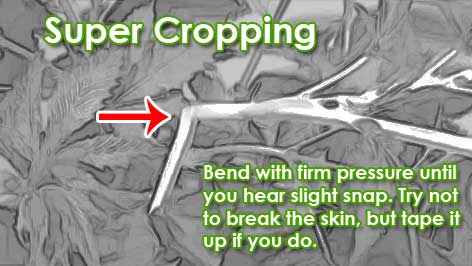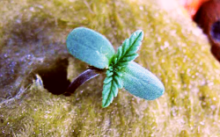You are hereQuick Guide to Marijuana Training Techniques
Quick Guide to Marijuana Training Techniques
by: Sirius Fourside
 Once a grower is able to successfully take a plant from seed (or clone) to harvest, a common new goal is: “How can I do it better?”
Once a grower is able to successfully take a plant from seed (or clone) to harvest, a common new goal is: “How can I do it better?”
The answer: efficiency!
Although cannabis is a weed and has an easy time growing, it doesn’t do so in an efficient manner for indoor growing.
Cannabis naturally tends to grow in the shape of a christmas tree which works great outside with a sun that moves through the sky. Yet inside the lights stay in the same place so it unfortunately means that parts of the plant are getting much more light than the others.
Although you can grow great bud this way, it wastes a great deal of the usable light you're paying for. That’s where “Cannabis Training” comes in!
Cannabis training is when growers use established or improvised techniques to alter the natural growth pattern of a marijuana plant, usually to increase efficiency and yields when growing indoors.
There are already many methods available to train your plant, and growers are experimenting with new techniques all the time. In fact, there are so many methods available that many people get confused or intimidated and opt to not try any of them.
But you're not one of those people! Instead, you're reading infomation on how to take advantage of these techniques to get the most out of your cannabis plants!
Below, I’ll give you my cheat notes on some of the most popular methods of training plants. We'll be reviewing:
 What It Does:
What It Does:
Low Stress Training - or LST - allows growers to change the actual shape of the plant by slowly bending the stems downward in a deliberate fashion. The stems will then grow vertically again, but now they will be better placed to allow light to contact more bud sites.
How To Do It:
Anyone who has done LST will agree that it’s an art in its own right. The basics are to use twistie-tie, twine, or something similar to tie to a stem. Next, the other end of the twistie-tie/twine/etc. is anchored in such a way as to bend the stem downward. This can be accomplished by tying the twine/etc. to the pot/bucket the plant is growing in. The stems are meant to be pulled away from each other to maximize growing space. Think of spreading out the stems from the middle like a star. LST is most effective when done in combination with topping, fimming or other training methods that break apical dominance (the tendency to grow in a christmas tree shape)
Who Should Try This?
Indoor growers of all skill levels can and should try LST. If you're doing a small grow or just trying to maximize on your indoor grow lights, LST will become a must after you've tried it once!
Pros:
- Drastically increases yields when done correctly
- Manages height of plants; makes shorter plants with more buds!
- Makes much more effective use of lights
- Works amazingly with topping/fimming
Cons:
- Growers can snap stems by bending too much at one time, or by trying to bend woody older stems instead of flexible new growth. If you ever snap a stem, tape it up immediately and it will heal!
- Can take more time than some other training methods since plants will likely need to be LST’d multiple times (per branch)
What It Does:
Topping is a method used to essentially force the cannabis plant to have two slightly smaller main colas instead of the single normal one. Main colas almost always have the highest concentration of buds (by weight), so yields are noticeably increased by making two of them, even if nothing else is done besides topping.
How To Do It:
Not only is Topping easy to do, but it only takes seconds and is totally done afterwards. To top your plant, you’ll need to wait until it grows at least 3 to 5 nodes. To finishing topping, simply cut off the newest node right above the leaves of the node below. You can also cut down further on the plant if you need to make it shorter.
Who Should Try This?
Like LST, topping is a great starter training technique and can be attempted by growers of all skill ranges. I would suggest topping after you've grown a single plant (just to see how it works), but you can try it on your first plant if you're the adventurous type!
Pros:
- Super easy to do
- Increases yields by a noticeable amount
- One cut; do it once and it’s done!
- Works amazingly with LST
Cons:
- Can be intimidating to cut off the top of a plant
What It Does:
Fimming is like topping in that it forces the plant to grow extra colas. However, while topping will make the plant to grow two main colas, fimming usually creates 4.
How To Do It:
As with topping, a grower should wait until their plant has at least 3 to 5 nodes before going through with fimming. When ready to fim your plant, firmly pinch the leaves of the newest growth between your index finger and thumb. You can also cut the new growth instead of pinching it. See the picture to the below for a detailed look.
Who Should Try This?
Fimming can be tried by all growers as nothing really happens if it isn't done correctly. Go for it!
Pros:
- Super easy to do - you can't really mess this one up
- Noticeable increase to yields
- Works extremely well with LST
- Pinch it once, and the work is all done
Cons:
- None! In the worst case (if not fimmed correctly), you’ll have a plant with a few weird looking leaves that still function.
What It Does:
Manifolding is a modified way of topping a plant multiple times to get it to distribute energy equally to all nodes. When done correctly, all remaining branches will get a equivalent amount of energy from the roots, and as such, grow to a similar size. The point of manifolding is to create 8 symmetrical main colas.
How To Do It:
Before attempting mainlining, growers should be very comfortable with topping as it involves topping the same plant multiple times. Below is the abridged version of how to mainline a plant.
Please note that these steps are just to get you acquainted with what’s involved in mainlining, these are not complete steps!
- Wait for the plant to grow 6 nodes.
- Top to 3rd node and remove extra growth
- Let each new cola grow 2-4 nodes
- Top to the 1st or 3rd node (whichever is more symmetric)
- Let the new colas grow 3 nodes
- Top to the 2nd node
At this point the plant will have 8 symmetrical colas.
Who Should Try This?
Manifolding is definitely an advanced technique, and we'd strongly advise growers to only try manifolding when they're very comfortable with growing plants. Manifolding can work in most mediums, but it shines brightest in hydroponics since the recovery time is dramatically shortened. It is not a good technique for small plants, since the plant needs to be at least a few feet tall to get the benefits of manifolding.
Pros:
- Equal distribution of energy makes for a hearty, good looking plant
- No small, larfy buds. All energy goes into long, huge colas
- Makes for efficient use of growing light
- Very noticeable increase in yields when performed correctly
Cons:
- Time consuming
- Involves lots of cutting on the plant (topping) which will increase total grow time
- Doesn’t work with fimming
- Not good for small plants - plants should be able to grow to at least a few feet tall after being manifolded in order to take advantage of the 8 colas (otherwise it's probably a waste of time)
- Not for beginners!
 What It Does:
What It Does:
Defoliation is a controversial technique that involves removing fan leaves to increase energy spent on bud sites. Defoliation is also thought to limit the amount that a plant will grow vertically.
How To Do It:
To defoliate a plant, a grower would use their hands or scissors to remove fan leaves from the plant. These are the leaves that grow right under the bud site and have a long stem with just a single fan leaf on it. It's important to note that this is typically done early in the flowering stage, and only on healthy plants with an abundance of light.
Who Should Try This?
This is another advanced technique, so you should only try it if growing cannabis feels easy, but you want to get more out of your grows. Growers who want to defoliate should be in early flowering (though it can be done in veg for height control) and using lights with enough power to penetrate to far into the canopy once the big fan leaves are gone.
Pros:
- Easy to do.
- Higher yields (more light to more bud sites = more bud)
- Creates more space between branches for bud sites to capitalize on.
- Tends to shorten the overall height of plants.
- Decreases chances of White Powdery Mold
Cons:
- A bit scary/dangerous; one wrong cut can remove future buds
- Defoliating gives you less room for error, and any deficiencies will hit bud sites first
- Some growers claim defoliation actually stunts plant growth instead of helping
- Sirius: I picked up defoliation after Nebula covered an article about its benefits. Since then, I defoliate in every grow and I’d definitely stand behind it as a valid way to increase efficiency and yields when done right.
Read more about cannabis defoliation
Even though we’ve gone through all these training methods, there are still more techniques to train your marijuana plants. In fact, there are two that are VERY popular that were skipped to keep this article from getting too lengthy.
If you want to find out more about them, check out our articles on:
Jump to...
LST (Low Stress Training) - How to Grow a Short Sativa or Haze
Nebula's Manifold Tutorial - Main-lining Cannabis
Cannabis Defoliation: Removing Leaves to Increase Yields









